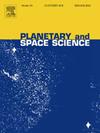通过气相沉积封住木卫二的火山口:一个数量级的研究
IF 1.7
4区 物理与天体物理
Q3 ASTRONOMY & ASTROPHYSICS
引用次数: 0
摘要
木卫二冰壳上的裂缝和喷口将地下海洋或液态水包裹体暴露在真空中,这可能是产生水蒸气羽流的原因。在穿过冰的过程中,烟羽蒸汽预计会部分凝结在寒冷的冰壁上。与其他影响(水溢出、压缩力等)一起,这种机制可能有助于密封排气口。在这项工作中,我们开发了一个简单的集总参数模型,可以量化通过水蒸气沉积来密封规定宽度的假设通风口的速度。作为一个例子,我们将我们的模型应用于2012年哈勃太空望远镜羽流探测推断的喷口大小和密度条件,预测密封时间约为30分钟。这表明实际的冰破裂可能比最初提出的要大,并且/或者喷口的羽流密度可能更低。虽然可能存在许多其他影响并负责密封喷口,但我们的估计表明,气相沉积可能在最终关闭观察到的羽流方面发挥了主要作用。给出了密封时间与羽流密度、质量流量和孔径面积的关系图。分析了文献中的羽流量,并与我们的结果进行了比较。对于给定的羽流密度/质量流率,小孔径会被气相沉积迅速密封,因此与观测结果不相容。本文章由计算机程序翻译,如有差异,请以英文原文为准。
Sealing Europa’s vents by vapor deposition: An order-of-magnitude study
Fractures and vents in the ice crust of Europa, exposing the sub-surface ocean or liquid–water inclusions to the vacuum, might be responsible for the generation of water-vapor plumes. During its passage through the ice, the plume vapor is expected to partially condense on the cold ice walls. Together with other effects (water spillage, compression forces, etc.) this mechanism likely contributes to sealing the vent. In this work, we develop a simple lumped-parameter model that can quantify how quickly a hypothetical vent of prescribed width would be sealed via water-vapor deposition. As an example, we apply our model to the vent size and density conditions inferred from the 2012 Hubble Space Telescope plume detection, predicting a sealing time of about 30 min. This suggests that the actual ice fracture might have been larger than originally proposed and/or the plume density at the vent might have been lower. While many other effects could have been present and responsible for sealing the vent, our estimates indicate that vapor deposition might have played a major role in eventually shutting off the observed plume. A map of sealing times vs. plume density, mass flow rate and aperture areas is given. Plume quantities from the literature are analyzed and compared to our results. For a given plume density/mass flow rate, small apertures would be sealed quickly by vapor deposition and are thus incompatible with observations.
求助全文
通过发布文献求助,成功后即可免费获取论文全文。
去求助
来源期刊

Planetary and Space Science
地学天文-天文与天体物理
CiteScore
5.40
自引率
4.20%
发文量
126
审稿时长
15 weeks
期刊介绍:
Planetary and Space Science publishes original articles as well as short communications (letters). Ground-based and space-borne instrumentation and laboratory simulation of solar system processes are included. The following fields of planetary and solar system research are covered:
• Celestial mechanics, including dynamical evolution of the solar system, gravitational captures and resonances, relativistic effects, tracking and dynamics
• Cosmochemistry and origin, including all aspects of the formation and initial physical and chemical evolution of the solar system
• Terrestrial planets and satellites, including the physics of the interiors, geology and morphology of the surfaces, tectonics, mineralogy and dating
• Outer planets and satellites, including formation and evolution, remote sensing at all wavelengths and in situ measurements
• Planetary atmospheres, including formation and evolution, circulation and meteorology, boundary layers, remote sensing and laboratory simulation
• Planetary magnetospheres and ionospheres, including origin of magnetic fields, magnetospheric plasma and radiation belts, and their interaction with the sun, the solar wind and satellites
• Small bodies, dust and rings, including asteroids, comets and zodiacal light and their interaction with the solar radiation and the solar wind
• Exobiology, including origin of life, detection of planetary ecosystems and pre-biological phenomena in the solar system and laboratory simulations
• Extrasolar systems, including the detection and/or the detectability of exoplanets and planetary systems, their formation and evolution, the physical and chemical properties of the exoplanets
• History of planetary and space research
 求助内容:
求助内容: 应助结果提醒方式:
应助结果提醒方式:


